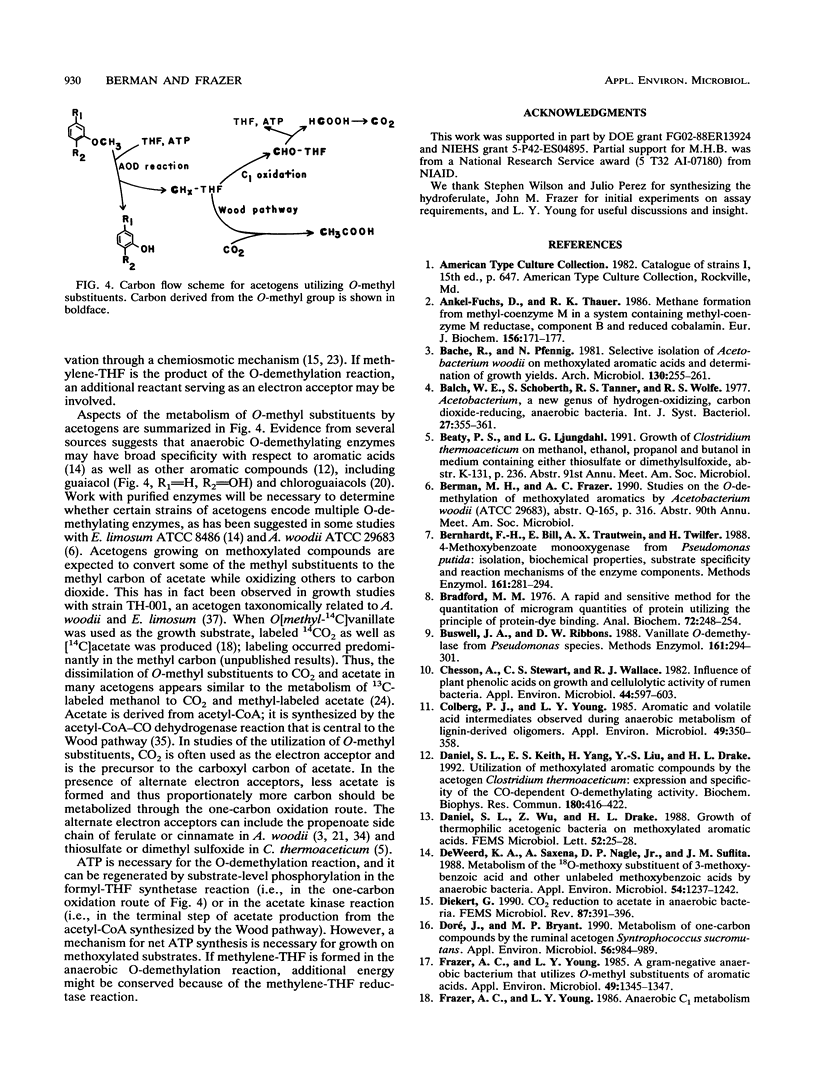Abstract
DL-Tetrahydrofolate (THF) and ATP were necessary for the anaerobic O-demethylation of phenylmethylethers in cell extracts of the type strain (ATCC 29683) of the homoacetogen Acetobacterium woodii. The reactants for this enzymatic activity have not been previously demonstrated in any system, nor has the mediating enzyme been studied. An assay using reaction mixtures containing 1 mM THF, 2 mM ATP, and 2 mM hydroferulate (i.e., 4-hydroxy,3-methoxyphenylpropionate) was developed and was performed under stringent anaerobic conditions. Pyridine nucleotides and several other possible cofactors were tested but had no effect on the activity. After centrifugation of disrupted cells at 27,000 x g, the activity was found primarily in the supernatant, which had a specific activity of 14.2 +/- 0.5 nmol/min/mg of protein. At saturating levels of each of the other two substrates, apparent Km values for the variable substrate were 0.65 mM hydroferulate, 0.27 mM ATP, and 0.17 mM THF. Activity was significantly decreased when extract was preincubated at 60 degrees C and was completely lost after preincubation in air for 30 min. Thus, the soluble anaerobic O-demethylating enzyme system of A. woodii is oxygen sensitive. The THF- and ATP-dependent activity measurable in the soluble fraction of cell extracts constituted about 34% of the activity seen with intact cells.
Full text
PDF






Selected References
These references are in PubMed. This may not be the complete list of references from this article.
- Ankel-Fuchs D., Thauer R. K. Methane formation from methyl-coenzyme M in a system containing methyl-coenzyme M reductase, component B and reduced cobalamin. Eur J Biochem. 1986 Apr 1;156(1):171–177. doi: 10.1111/j.1432-1033.1986.tb09563.x. [DOI] [PubMed] [Google Scholar]
- Bernhardt F. H., Bill E., Trautwein A. X., Twilfer H. 4-Methoxybenzoate monooxygenase from Pseudomonas putida: isolation, biochemical properties, substrate specificity, and reaction mechanisms of the enzyme components. Methods Enzymol. 1988;161:281–294. doi: 10.1016/0076-6879(88)61031-7. [DOI] [PubMed] [Google Scholar]
- Bradford M. M. A rapid and sensitive method for the quantitation of microgram quantities of protein utilizing the principle of protein-dye binding. Anal Biochem. 1976 May 7;72:248–254. doi: 10.1016/0003-2697(76)90527-3. [DOI] [PubMed] [Google Scholar]
- Buswell J. A., Ribbons D. W. Vanillate O-demethylase from Pseudomonas species. Methods Enzymol. 1988;161:294–301. doi: 10.1016/0076-6879(88)61032-9. [DOI] [PubMed] [Google Scholar]
- Chesson A., Stewart C. S., Wallace R. J. Influence of plant phenolic acids on growth and cellulolytic activity of rumen bacteria. Appl Environ Microbiol. 1982 Sep;44(3):597–603. doi: 10.1128/aem.44.3.597-603.1982. [DOI] [PMC free article] [PubMed] [Google Scholar]
- Colberg P. J., Young L. Y. Aromatic and Volatile Acid Intermediates Observed during Anaerobic Metabolism of Lignin-Derived Oligomers. Appl Environ Microbiol. 1985 Feb;49(2):350–358. doi: 10.1128/aem.49.2.350-358.1985. [DOI] [PMC free article] [PubMed] [Google Scholar]
- Daniel S. L., Keith E. S., Yang H., Lin Y. S., Drake H. L. Utilization of methoxylated aromatic compounds by the acetogen Clostridium thermoaceticum: expression and specificity of the co-dependent O-demethylating activity. Biochem Biophys Res Commun. 1991 Oct 15;180(1):416–422. doi: 10.1016/s0006-291x(05)81309-9. [DOI] [PubMed] [Google Scholar]
- DeWeerd K. A., Saxena A., Nagle D. P., Jr, Suflita J. M. Metabolism of the 18O-methoxy substituent of 3-methoxybenzoic acid and other unlabeled methoxybenzoic acids by anaerobic bacteria. Appl Environ Microbiol. 1988 May;54(5):1237–1242. doi: 10.1128/aem.54.5.1237-1242.1988. [DOI] [PMC free article] [PubMed] [Google Scholar]
- Doré J., Bryant M. P. Metabolism of One-Carbon Compounds by the Ruminal Acetogen Syntrophococcus sucromutans. Appl Environ Microbiol. 1990 Apr;56(4):984–989. doi: 10.1128/aem.56.4.984-989.1990. [DOI] [PMC free article] [PubMed] [Google Scholar]
- Frazer A. C., Young L. Y. A gram-negative anaerobic bacterium that utilizes o-methyl substituents of aromatic acids. Appl Environ Microbiol. 1985 May;49(5):1345–1347. doi: 10.1128/aem.49.5.1345-1347.1985. [DOI] [PMC free article] [PubMed] [Google Scholar]
- Frazer A. C., Young L. Y. Anaerobic c(1) metabolism of the o-methyl-C-labeled substituent of vanillate. Appl Environ Microbiol. 1986 Jan;51(1):84–87. doi: 10.1128/aem.51.1.84-87.1986. [DOI] [PMC free article] [PubMed] [Google Scholar]
- Hsu T., Daniel S. L., Lux M. F., Drake H. L. Biotransformations of carboxylated aromatic compounds by the acetogen Clostridium thermoaceticum: generation of growth-supportive CO2 equivalents under CO2-limited conditions. J Bacteriol. 1990 Jan;172(1):212–217. doi: 10.1128/jb.172.1.212-217.1990. [DOI] [PMC free article] [PubMed] [Google Scholar]
- Hugenholtz J., Ljungdahl L. G. Metabolism and energy generation in homoacetogenic clostridia. FEMS Microbiol Rev. 1990 Dec;7(3-4):383–389. doi: 10.1111/j.1574-6968.1990.tb04941.x. [DOI] [PubMed] [Google Scholar]
- Kerby R., Niemczura W., Zeikus J. G. Single-carbon catabolism in acetogens: analysis of carbon flow in Acetobacterium woodii and Butyribacterium methylotrophicum by fermentation and 13C nuclear magnetic resonance measurement. J Bacteriol. 1983 Sep;155(3):1208–1218. doi: 10.1128/jb.155.3.1208-1218.1983. [DOI] [PMC free article] [PubMed] [Google Scholar]
- Kirk T. K., Farrell R. L. Enzymatic "combustion": the microbial degradation of lignin. Annu Rev Microbiol. 1987;41:465–505. doi: 10.1146/annurev.mi.41.100187.002341. [DOI] [PubMed] [Google Scholar]
- Ljungdahl L. G. The autotrophic pathway of acetate synthesis in acetogenic bacteria. Annu Rev Microbiol. 1986;40:415–450. doi: 10.1146/annurev.mi.40.100186.002215. [DOI] [PubMed] [Google Scholar]
- Lux M. F., Keith E., Hsu T. D., Drake H. L. Biotransformations of aromatic aldehydes by acetogenic bacteria. FEMS Microbiol Lett. 1990 Jan 15;55(1-2):73–77. doi: 10.1016/0378-1097(90)90171-l. [DOI] [PubMed] [Google Scholar]
- Scrimgeour K. G. Methods for reduction, stabilization, and analyses of folates. Methods Enzymol. 1980;66:517–523. doi: 10.1016/0076-6879(80)66496-9. [DOI] [PubMed] [Google Scholar]
- Sutherland J. B. Demethylation of Veratrole by Cytochrome P-450 in Streptomyces setonii. Appl Environ Microbiol. 1986 Jul;52(1):98–100. doi: 10.1128/aem.52.1.98-100.1986. [DOI] [PMC free article] [PubMed] [Google Scholar]
- Wu Z. R., Daniel S. L., Drake H. L. Characterization of a CO-dependent O-demethylating enzyme system from the acetogen Clostridium thermoaceticum. J Bacteriol. 1988 Dec;170(12):5747–5750. doi: 10.1128/jb.170.12.5747-5750.1988. [DOI] [PMC free article] [PubMed] [Google Scholar]


